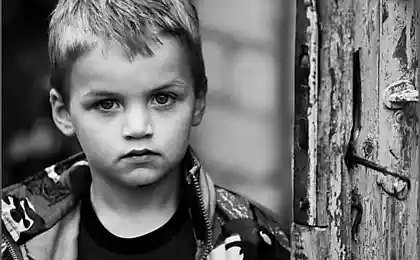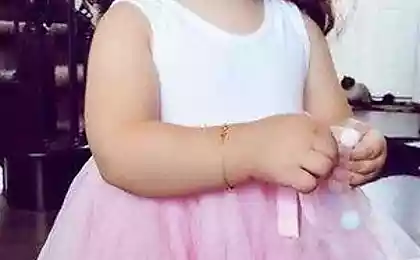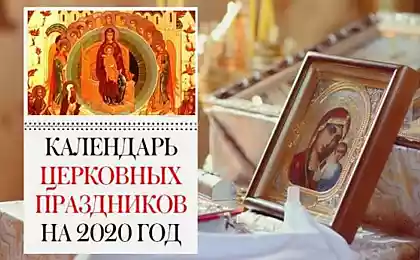767
Excessive parental care: an Important key to finding the "Golden mean"
Instead of saying "be careful", you say "be careful"is an Important key to finding the "Golden mean" between security and risk, ultimately, is the following: instead of protecting children from risk, you teach them to deal with the risk.
This includes the management of three dynamic acts:

Creating an environment of controlled risk
In their study on the role of risk in childhood Ellen Sangster claims that exposure plays an important role in children's development, it "educates" children from excessive fear and brings such resistance, which will allow them to succeed in adult life. However, she notes that children do not need to actually face serious risks to achieve these benefits; they only have to participate in situations which are perceived as risks.
For adults this means that instead of going to extremes to eliminate all risks or to push children into situations that can cause them real injury or harm – you can choose a middle way: to encourage children to go on controlled risks. To evaluate and control situations that provides controlled risk, parents should ask themselves a few questions:
That's a risk my child may expect himself?
This is a risk which can cause him serious harm (death, paralysis, head injury)?
It's a risk that can teach a positive lesson?
Then the answers to these questions can be used to find the balance between risk and safety:

Next, we consider the latter.
Focus on full preparation and not full protection
When parents are too protective of their children, they, in essence, take care of all risk management of their offspring. The working assumption is that mom and dad will always be there to protect them from harm, but of course it will not (we hope).
Instead of making children dependent on the security, cook them to ensure that they themselves are met and manage risks. This means not pushing them into a situation without backup, but rather use that which Geever Tully calls the "stage of planning, phased implementation and take reasonable precautions." The strength of that stage must be regulated in accordance with the age and maturity level of children, and then they should gradually get out – as soon as children will gain confidence and competence and gain the ability to defend himself. Here are a few keys to that use this process, which not only will benefit your children, but will lessen your own anxiety:
Enter the risk gradually. The first step in allowing children to engage in "risky" thing to determine is what are the risks.
Once you identify risks, you will be able to understand how to weaken them and reduce their anxiety in ways that 1) proportional to the risk, 2) retain a sense of risk (excitement, awe, fear), and 3) increase the competence and autonomy of the child.
In his book "Free the children" Lenore Skenazy offers perhaps the best way to achieve all three objectives: the introduction in several stages, during which you tell the child about these activities, the inherent dangers and then gradually reduce their management and supervision. For example:
Crossing the street:
1. Cross the street, holding their child's hand and telling him about the need to look both ways and watch for cars.
2. Cross the street, not holding hands, but stay close with your child.
3. Watch as your child crosses the street from the curb.
4. Allow your child to cross the street without your presence.
Instead of saying "be careful", you say "be careful". The constant repetition of the words "be careful" is the world as initially disastrous, too dangerous a place and inculcate in children a careful mind. On the contrary, the words "be careful" (or "watch what you're doing") encourage children more aware of their body and the environment – a mentality that we want to develop in our children regardless of whether they do risky things or not. The world does not need more careful children – he needs a wise, sensitive and brave children.
Contact us with your children and students. A modern phenomenon, reflected in the fact that children most of the time in close proximity to their parents, did not appear in the modern era. Before the industrial revolution children also spent their time side by side with mom and dad. But if parents act as passive witnesses standing on the sidelines observer of his children, before parents and children worked together. The children have been informal (and sometimes formal) training with these adults, gaining skills and knowledge which they will need for success in adult life.
It is time to return to this idea of discipleship. There is nothing wrong with spending a lot of time with their children – in fact, it can be a very good thing – but this time can be used better (both for you and for them). Most parents can't every day to take children to work, but you probably already spend most of their free time with their children; instead throw their Hobbies and to do household chores when the children are in bed, use this time to engage in these activities,allowing your children to accompany you and learn more about your pastime, and also to get some practical skills.
Take the kids Hiking and tell them about the dangers and delights of the forest. Toss together and let them advice in an appropriate form, instilling a love of fitness. Let them help you rake the leaves or cooking dinner (including using! – sharp knife), even if their "help" in the beginning is insignificant, if not harmful.
If you treat your children as pupils, this will allow you not only to teach them important skills, but also, indirectly, become less Intrusive parent. I was surprised that being such an all-consuming, to the waiver of any party/adult interests, excessive parental custody was not actually developed its own cycle of giperstimulatia and dependence: not only children are dependent on parents, but parents become dependent on their children as the only friends and interests in your life. Therefore, start some Hobbies and interests, mom and dad, and show your children and yourself that you are fully formed people, in addition to your role as parents.
Do not interfere in the quarrel and the activities of their children. One of the negative results of the permanent control associated with excessive parental care, is that now mom and dad are always close to resolve common disputes that arise between children playing.The importance of unstructured play for a child's development partly lies in the fact that children must learn to negotiate and compromise. Of course, parents can teach them some principles of mutual concessions, but if they do not practice them, they grow up with the belief that whenever they will feel that they have harmed or did them poorly, they will present themselves as victims, which remains nothing how to ask for help to a third party (the fruits of this dynamic is apparent in modern culture).
The same principle applies to your observation on how children perform their own "dangerous" projects "do it yourself". In the framework of the gradual introduction of risk and the permission to your children to be a disciple, you will, of course, in the beginning to observe how a child relates with instruments, makes something and so on. But you should step aside, allowing them to understand ourselves, and offer your advice or to do something on their own only if they are physically unable to do it yourself or put yourself in immediate danger.

Use a different approach to the training of their children to the "dangers of strangers" (since the abandonment of the phrase "danger of strangers"). When it comes to reducing the already meager greatest fear of parents – child abduction – all of us usually are approaching this wrong.
As a rule, we only learn that strangers should never speak. But according to Ernie Allen, head of the National center for missing and victimized children, it is a categorical requirement, "in essence, removes hundreds of good people in the area who could help."
Therefore, telling children how to treat strangers better not to use the phrase "Never talk to strangers", and the phrase "do not go Anywhere with strangers". And then you explain to children what it means. Tell the children that they do not pay attention to the lures that can be used by attackers to lure them into the machine – the candy or the leash, which allegedly belongs to the dog he is looking for. Tell them that they did not go with a stranger, even if he says something is good, or that he needs help. Tell the children that they raised the noise and bolted out of there, if someone tries to grab them.
Instilling this mindset and this training children helps them to narrow the focus of danger, and not to spread it on everything, and also allows the children more confident to mix in the world and communicate with other people. And, perhaps equally important, advanced training for children allows parents to feel safe letting their children walk outside the back yard.
One thing to know how to balance risk and safety in the lives of their children; the other constantly apply these principles in practice. Your efforts to educate "free" children can very easily nullify the primitive fear (whatever it was irrational) about the fact that with them can happen something bad. Adherence to the following mental attitudes will help you not to abandon its good intentions.
Make it the main element in your parenting philosophy. You will not succeed in providing their children with greater independence, if you think about it casually, and mostly let it go. If you want to raise "free" children in careful modern society, you need to really believe that it's important to put this belief at the centre of its parent philosophy.
Do not forget about the statistics on waiting children in harm's way. People often say that statistics have no influence on fear, because they are based on reason, but fear not. It's true that people irrationally believe that the world is a more dangerous though he is not, and that the risk of child abduction is great, although in reality it is negligible. Also, is it true that these fears are lower, "reptilian" parts of our brain, not in his higher parts.
The next time you will insist that your child was driven to school by car, citing too much danger of Hiking, remember that your child is 40 times more likely to die as a passenger in a car than to be kidnapped or killed by a stranger, and that half of the children that come under the car near the school, knock landed.
The statistics do not cure you of anxiety, but when around the baby news of the tragedy seem to be more frequent and bloody, than it actually is, it will help you relax; it's okay to continue to worry, just do your concern proportionate to the threat.
Use the story to create a perspective. In the early twentieth century children, even very young, worked 12 hours in the mines and factories and spread Newspapers on the corners of the dark streets. In this child labor is nothing romantic, but, in contrast to the imaginary dangers of the modern world, this work posed a real risk to the children. But the knowledge of the past can help you realize that children could have much greater autonomy to better cope with more risk and to assume greater responsibility than they allow.
At the age of seventeen, Jack London set sail on the schooner, engaged in hunting for seals in the Bering sea. At the age of thirteen, Andrew Jackson served as a courier in the American militia during the revolutionary war. At the age of twelve years, Louis Zamperini went home and spent the summer living on an Indian reservation and running in the mountains; he lived in a hut with a friend the same age and each day brought a lunch with a shotgun.
If these children were able to swim oceans, to serve on the military front and to live independently, our kids can ride bikes to school.
Beware of the cycle of vulnerability (and turn it into a cycle of autonomy). The cycle of excessive parental care is expressed as follows: parents feel that their children fragile and unable to defend themselves, and treat them accordingly. As a result, children do not possess the skills necessary to overcome risks and failures, and act like vulnerable. Then it is a manifestation of vulnerability justifies parental control and interference, which further alienates children from independence and risk. This makes them more vulnerable and so on.
If you think your children are pretty helpless and dependent on your leadership, so they could do your constant control.
Fortunately, this cycle is reversible: the more capable and competent will become your children, the more they will give you autonomy;and the more autonomy they will give you, the more able and competent they will become. published
translation by Sergey Maltsev
P. S. And remember, just changing your mind — together we change the world! ©
Source: //muz4in.net/news/tri_kljucha_k_uravnoveshivaniju_bezopasnosti_i_riska_v_vospitanii_detej/2017-04-29-43061
This includes the management of three dynamic acts:
- exposure of children to controlled risk;
- to prepare children to take risks, instead of its complete elimination;
- support approach to education, which is expressed in total freedom.

Creating an environment of controlled risk
In their study on the role of risk in childhood Ellen Sangster claims that exposure plays an important role in children's development, it "educates" children from excessive fear and brings such resistance, which will allow them to succeed in adult life. However, she notes that children do not need to actually face serious risks to achieve these benefits; they only have to participate in situations which are perceived as risks.
For adults this means that instead of going to extremes to eliminate all risks or to push children into situations that can cause them real injury or harm – you can choose a middle way: to encourage children to go on controlled risks. To evaluate and control situations that provides controlled risk, parents should ask themselves a few questions:
That's a risk my child may expect himself?
This is a risk which can cause him serious harm (death, paralysis, head injury)?
It's a risk that can teach a positive lesson?
Then the answers to these questions can be used to find the balance between risk and safety:
- If it is a risk that children can't (at least in the beginning) to anticipate on their own, point them to danger. Teach them how to find and deal with these dangers that in the future they could anticipate and manage them. Example: allow children to cross the street independently, but teach them to look both ways.
- If the child is too small for anticipating and understanding the serious risk, even with training, removed from its environment the risk and leave only those risks that can cause little damage (bumps, scratches) and that will contribute to learning. Example: do not let children play near the edge of the cliff, but let them climb and jump off big rocks located farther from the edge.
- Protect children from the risks they can foresee, but which can still cause them serious harm and do not give valuable experience in return. Example: do not allow children to jump from the roof of the house; that is a bad idea, it is possible to convey in words, it does not require verification by experience.
- Allow children to participate in the risks they carry very little chance of serious harm, but offer in return a very valuable experience. Example: allow the child to explore; it carries a negligible chance of theft (which can be reduced), but offers an indispensable opportunity for development of autonomy.

Next, we consider the latter.
Focus on full preparation and not full protection
When parents are too protective of their children, they, in essence, take care of all risk management of their offspring. The working assumption is that mom and dad will always be there to protect them from harm, but of course it will not (we hope).
Instead of making children dependent on the security, cook them to ensure that they themselves are met and manage risks. This means not pushing them into a situation without backup, but rather use that which Geever Tully calls the "stage of planning, phased implementation and take reasonable precautions." The strength of that stage must be regulated in accordance with the age and maturity level of children, and then they should gradually get out – as soon as children will gain confidence and competence and gain the ability to defend himself. Here are a few keys to that use this process, which not only will benefit your children, but will lessen your own anxiety:
Enter the risk gradually. The first step in allowing children to engage in "risky" thing to determine is what are the risks.
Once you identify risks, you will be able to understand how to weaken them and reduce their anxiety in ways that 1) proportional to the risk, 2) retain a sense of risk (excitement, awe, fear), and 3) increase the competence and autonomy of the child.
In his book "Free the children" Lenore Skenazy offers perhaps the best way to achieve all three objectives: the introduction in several stages, during which you tell the child about these activities, the inherent dangers and then gradually reduce their management and supervision. For example:
Crossing the street:
1. Cross the street, holding their child's hand and telling him about the need to look both ways and watch for cars.
2. Cross the street, not holding hands, but stay close with your child.
3. Watch as your child crosses the street from the curb.
4. Allow your child to cross the street without your presence.
Instead of saying "be careful", you say "be careful". The constant repetition of the words "be careful" is the world as initially disastrous, too dangerous a place and inculcate in children a careful mind. On the contrary, the words "be careful" (or "watch what you're doing") encourage children more aware of their body and the environment – a mentality that we want to develop in our children regardless of whether they do risky things or not. The world does not need more careful children – he needs a wise, sensitive and brave children.
Contact us with your children and students. A modern phenomenon, reflected in the fact that children most of the time in close proximity to their parents, did not appear in the modern era. Before the industrial revolution children also spent their time side by side with mom and dad. But if parents act as passive witnesses standing on the sidelines observer of his children, before parents and children worked together. The children have been informal (and sometimes formal) training with these adults, gaining skills and knowledge which they will need for success in adult life.
It is time to return to this idea of discipleship. There is nothing wrong with spending a lot of time with their children – in fact, it can be a very good thing – but this time can be used better (both for you and for them). Most parents can't every day to take children to work, but you probably already spend most of their free time with their children; instead throw their Hobbies and to do household chores when the children are in bed, use this time to engage in these activities,allowing your children to accompany you and learn more about your pastime, and also to get some practical skills.
Take the kids Hiking and tell them about the dangers and delights of the forest. Toss together and let them advice in an appropriate form, instilling a love of fitness. Let them help you rake the leaves or cooking dinner (including using! – sharp knife), even if their "help" in the beginning is insignificant, if not harmful.
If you treat your children as pupils, this will allow you not only to teach them important skills, but also, indirectly, become less Intrusive parent. I was surprised that being such an all-consuming, to the waiver of any party/adult interests, excessive parental custody was not actually developed its own cycle of giperstimulatia and dependence: not only children are dependent on parents, but parents become dependent on their children as the only friends and interests in your life. Therefore, start some Hobbies and interests, mom and dad, and show your children and yourself that you are fully formed people, in addition to your role as parents.
Do not interfere in the quarrel and the activities of their children. One of the negative results of the permanent control associated with excessive parental care, is that now mom and dad are always close to resolve common disputes that arise between children playing.The importance of unstructured play for a child's development partly lies in the fact that children must learn to negotiate and compromise. Of course, parents can teach them some principles of mutual concessions, but if they do not practice them, they grow up with the belief that whenever they will feel that they have harmed or did them poorly, they will present themselves as victims, which remains nothing how to ask for help to a third party (the fruits of this dynamic is apparent in modern culture).
The same principle applies to your observation on how children perform their own "dangerous" projects "do it yourself". In the framework of the gradual introduction of risk and the permission to your children to be a disciple, you will, of course, in the beginning to observe how a child relates with instruments, makes something and so on. But you should step aside, allowing them to understand ourselves, and offer your advice or to do something on their own only if they are physically unable to do it yourself or put yourself in immediate danger.

Use a different approach to the training of their children to the "dangers of strangers" (since the abandonment of the phrase "danger of strangers"). When it comes to reducing the already meager greatest fear of parents – child abduction – all of us usually are approaching this wrong.
As a rule, we only learn that strangers should never speak. But according to Ernie Allen, head of the National center for missing and victimized children, it is a categorical requirement, "in essence, removes hundreds of good people in the area who could help."
Therefore, telling children how to treat strangers better not to use the phrase "Never talk to strangers", and the phrase "do not go Anywhere with strangers". And then you explain to children what it means. Tell the children that they do not pay attention to the lures that can be used by attackers to lure them into the machine – the candy or the leash, which allegedly belongs to the dog he is looking for. Tell them that they did not go with a stranger, even if he says something is good, or that he needs help. Tell the children that they raised the noise and bolted out of there, if someone tries to grab them.
Instilling this mindset and this training children helps them to narrow the focus of danger, and not to spread it on everything, and also allows the children more confident to mix in the world and communicate with other people. And, perhaps equally important, advanced training for children allows parents to feel safe letting their children walk outside the back yard.
One thing to know how to balance risk and safety in the lives of their children; the other constantly apply these principles in practice. Your efforts to educate "free" children can very easily nullify the primitive fear (whatever it was irrational) about the fact that with them can happen something bad. Adherence to the following mental attitudes will help you not to abandon its good intentions.
Make it the main element in your parenting philosophy. You will not succeed in providing their children with greater independence, if you think about it casually, and mostly let it go. If you want to raise "free" children in careful modern society, you need to really believe that it's important to put this belief at the centre of its parent philosophy.
Do not forget about the statistics on waiting children in harm's way. People often say that statistics have no influence on fear, because they are based on reason, but fear not. It's true that people irrationally believe that the world is a more dangerous though he is not, and that the risk of child abduction is great, although in reality it is negligible. Also, is it true that these fears are lower, "reptilian" parts of our brain, not in his higher parts.
The next time you will insist that your child was driven to school by car, citing too much danger of Hiking, remember that your child is 40 times more likely to die as a passenger in a car than to be kidnapped or killed by a stranger, and that half of the children that come under the car near the school, knock landed.
The statistics do not cure you of anxiety, but when around the baby news of the tragedy seem to be more frequent and bloody, than it actually is, it will help you relax; it's okay to continue to worry, just do your concern proportionate to the threat.
Use the story to create a perspective. In the early twentieth century children, even very young, worked 12 hours in the mines and factories and spread Newspapers on the corners of the dark streets. In this child labor is nothing romantic, but, in contrast to the imaginary dangers of the modern world, this work posed a real risk to the children. But the knowledge of the past can help you realize that children could have much greater autonomy to better cope with more risk and to assume greater responsibility than they allow.
At the age of seventeen, Jack London set sail on the schooner, engaged in hunting for seals in the Bering sea. At the age of thirteen, Andrew Jackson served as a courier in the American militia during the revolutionary war. At the age of twelve years, Louis Zamperini went home and spent the summer living on an Indian reservation and running in the mountains; he lived in a hut with a friend the same age and each day brought a lunch with a shotgun.
If these children were able to swim oceans, to serve on the military front and to live independently, our kids can ride bikes to school.
Beware of the cycle of vulnerability (and turn it into a cycle of autonomy). The cycle of excessive parental care is expressed as follows: parents feel that their children fragile and unable to defend themselves, and treat them accordingly. As a result, children do not possess the skills necessary to overcome risks and failures, and act like vulnerable. Then it is a manifestation of vulnerability justifies parental control and interference, which further alienates children from independence and risk. This makes them more vulnerable and so on.
If you think your children are pretty helpless and dependent on your leadership, so they could do your constant control.
Fortunately, this cycle is reversible: the more capable and competent will become your children, the more they will give you autonomy;and the more autonomy they will give you, the more able and competent they will become. published
translation by Sergey Maltsev
P. S. And remember, just changing your mind — together we change the world! ©
Source: //muz4in.net/news/tri_kljucha_k_uravnoveshivaniju_bezopasnosti_i_riska_v_vospitanii_detej/2017-04-29-43061
Oil giants admitted: electric boom – a factor that will have to be considered
These 5 movements will determine your physical fitness























